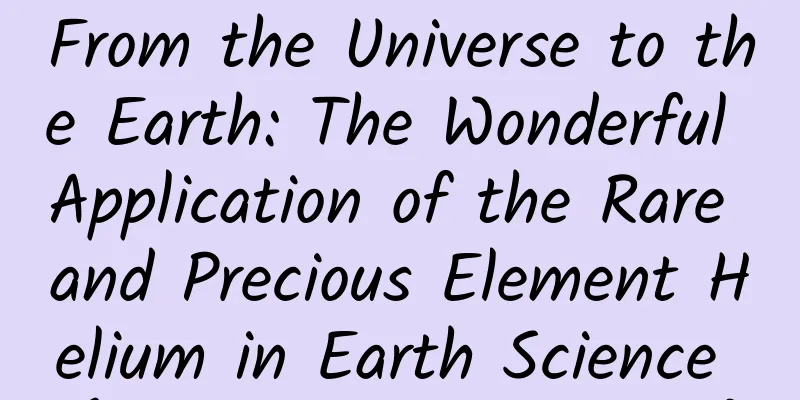From the Universe to the Earth: The Wonderful Application of the Rare and Precious Element Helium in Earth Science (Author: Li Zhongping)

|
introduction In daily life, most people may pay little attention to the secrets deep in the earth, however, earth scientists have been exploring these mysterious areas. Rare gases, also known as inert gases, are not as well known as elements such as iron, copper and lead, but they play a very important role in earth science research. Rare gases are called mysterious messengers from deep in the earth, especially helium isotopes. Due to their very stable chemical properties, they can not only be used to reveal the sources of rocks and gases on the earth's surface, but also contain a lot of information about the formation history and evolution process of the deep earth, and even help people deeply understand many unknown basic scientific problems such as the evolution of the vast universe. Therefore, helium and its isotope geochemical tracing technology has become a unique means in the field of earth science. Here, through a simple introduction to the basic knowledge of helium isotope geochemistry. I hope to attract more people, especially many people, to pay close attention to the innovative development and various challenges faced in the field of earth science. Figure 1. Different rare gases will produce different spectral colors when discharged or excited, so spectral colors can be used to distinguish different gases. (Helium (He): orange-yellow; neon (Ne): orange-red; argon (Ar): blue-purple; krypton (Kr): gray-blue; xenon (Xe): blue-green) The second most abundant element in the universe, why is it so rare on Earth? After hydrogen atoms, helium is the second lightest and second most abundant element in the observable universe, accounting for about 24% of the mass of elements in the entire universe (Wikipedia). However, helium is very rare in the Earth system, with a volume percentage of only about 5 parts per million in the atmosphere. This is because helium is very "light" and the Earth's gravity is not enough to attract it to stay in the atmosphere, and it will easily escape into space. Because its molecules are too light and are affected by heat. The solar wind is a stream of charged particles flowing out of the high-temperature plasma in the solar atmosphere. It contains abundant elements such as helium, which is ionized and escapes into space along the Earth's magnetic field lines. The inertness of helium prevents it from combining with other substances through chemical reactions and remaining on the Earth's surface. In contrast, although hydrogen is lighter, it can form compounds, common hydrogen-containing compounds, such as combining with oxygen to form water, combining with carbon to form various hydrocarbons, especially organic matter, etc. Therefore, there is a large amount of hydrogen on Earth, but helium is very rare. Figure 2. Helium is a product of the evolution of the universe. Nuclear fusion inside stars is an important process in the evolution of elements in the universe. Through nuclear fusion, hydrogen can be fused into helium, and helium can further undergo nuclear fusion to generate heavier elements (Image source: Science and Technology Daily) How are helium isotope ratios measured? Isotopes refer to nuclides or atoms with the same number of protons but different numbers of neutrons, occupying the same position on the periodic table. The isotope ratio is the ratio of the number of atoms of different isotopes of a certain element. For example, the 3He/4He ratio is the ratio of the number of atoms of the 3He and 4He isotopes of helium. The measurement of isotope ratios can be used to determine the age of a substance or sample, geological age, geochemical process, biological process, etc. However, due to the extremely low content of noble gases in the Earth system, it is very difficult to measure and analyze them. To measure the isotope ratio of helium, a noble gas mass spectrometer is used, which is a magical instrument that can measure the ratio of noble gas isotopes including helium, neon, argon, krypton and xenon. In order to cope with this measurement problem, the noble gas mass spectrometer uses static vacuum and high-resolution technology to make the analysis test more accurate and reliable. The test process is as follows: First, the sample to be tested containing rare gases is heated or irradiated with a laser to release the relevant rare gases. Then, the released gases are sent to the gas treatment system for purification and separation to remove impurities. Next, the purified rare gases are sent to the mass spectrometer host. In the host, the gas will be bombarded by electrons to form He ions. Subsequently, the electromagnetic field will separate the ions according to different masses, and different detectors will be used to measure ion signals with different masses according to a certain procedure. In this way, the ratio of various isotopes of rare gases can be obtained. Figure 3. Static vacuum mass spectrometer for noble gas isotope measurement (Website of Geochemical Analysis and Testing Center, Northwest Institute of Eco-Environment and Resources, Chinese Academy of Sciences) How to use helium isotope ratio to distinguish helium from different sources? There are 8 isotopes of helium, only two of which are stable, namely 4He and 3He. The other isotopes are unstable, which means they emit energy and disappear quickly. There are two main sources of 4He and 3He within the Earth system. One is the original 3He, which was produced during the Big Bang and also produced during fusion inside stars. It mainly exists inside the Earth and can be released to the surface through volcanoes or deep-sea hydrothermal fluids. The other is radiogenic 4He, which is formed by particles released when radioactive elements (such as thorium, uranium and potassium) decay in the Earth's crust. This 4He is mainly found in the Earth's crust, especially in sedimentary basins, and can be released to the surface through fractures or geological fluids. Helium on Earth is generally composed of 4He and 3He. There are significant differences in the 3He/4He ratio of helium from different sources. Original helium, such as helium from solar system material, usually has a higher 3He/4He ratio, about 10^-4. This is because the isotope ratio of helium was fixed when the solar system was formed, so it can be used to determine the origin and evolution of solar system material. Helium of radioactive origin, such as helium produced in the earth's interior, usually has a lower 3He/4He ratio, about 10^-8 to 10^-7. This is because the helium produced in the earth's interior mainly comes from 4He from radioactive decay, and the decay of radioactive isotopes will cause the helium isotope ratio to change. Figure 4. The process of helium exchange between the core and mantle of the Earth (a) During the Earth's formation, helium-3 was absorbed from the nebula atmosphere and transported to the primordial core through the magma ocean; and (b) Helium-3 transport from the core to the mantle and from the mantle to the ocean (Image source: Olson & Sharp, 2022) How to use helium isotopes to study the evolution and circulation of matter inside the Earth? How to use helium isotopes to study the composition, evolution and circulation of materials inside the earth? For example, people can measure the helium isotope ratio in samples from the mantle in different regions, and then study the origin and evolution history of mantle materials. If the helium isotope ratio in a region is higher than the average level, it may mean that the test samples in the region come from more primitive mantle materials; conversely, if the ratio is lower, it may mean that the specific region represented by the sample has experienced more material mixing and recycling. For example, on the island of Hawaii, the helium isotope ratio in volcanic rocks is as high as 40 times or even higher than the atmospheric level, indicating that the volcanic magma of the island of Hawaii may come from the deep, primitive or unique mantle materials of the earth, and form unique volcanic rocks (geologists call it hotspots). On the mid-ocean ridge of the Atlantic Ocean, the helium isotope ratio in the seafloor basalt is only 8 times the atmospheric level, which may indicate that the mid-ocean ridge of the Atlantic Ocean comes from a relatively shallow layer, accompanied by mixing, or a common mantle source. Figure 5. Distribution range of helium isotope values from different sources in nature (Yuji Sano, 2018) Figure 5 shows the relative abundance of different types of helium isotopes (3He and 4He) in different sources (such as the atmosphere, mantle, crust, seawater, extraterrestrial bodies, etc.), as well as the mixing relationship between them. Ra in the chart represents the ratio of the 3He/4He ratio in the sample to the 3He/4He ratio in the atmosphere, which is used to reflect the composition and source of the helium isotopes in the sample. Applications and future challenges of helium isotope geochemistry Although the application of helium isotopes in geochemical research has made great progress, there are still many unknown areas for us to explore. For example, we still do not know the helium isotope composition and distribution of certain regions in the Earth's interior, and the impact of the Earth's evolution on them. In addition, helium isotopes can also be used to study extraterrestrial bodies, such as planets and meteorites in the solar system, to better understand the formation and evolution of the universe. Helium isotope technology is currently widely used in research in the fields of earth science, space science, and nuclear science. For example, we can measure the ratio of noble gas isotopes in rocks, groundwater, or meteorites to infer their formation age, source, and evolution process. Helium from different sources has different isotope ratios because they have undergone different evolution processes inside the earth. By measuring the ratio of noble gas isotopes, we can explore the movement and evolution of the earth's interior, determine the origin and distribution of mineral deposits, and even predict the possibility of earthquakes and volcanic eruptions. Future challenges facing helium isotope geochemistry may include the following aspects: ① Improving the accuracy and sensitivity of helium isotope analysis to meet the measurement needs of extremely low abundance samples; ② Expanding the scope and depth of application of helium isotopes in different media (such as rocks, fluids, gases, organisms, etc.) to reveal more earth science problems; ③ Exploring the coupling relationship between helium isotopes and other rare gas isotopes (such as neon, argon, krypton, xenon, etc.) to enhance the understanding of the complex processes of the Earth system. Geopolitical conflicts have caused a surge in helium prices, and "gas gold" urgently needs domestic substitution Helium is an important strategic resource, and its global supply is very concentrated. It is widely used in aerospace, semiconductor industry, cutting-edge scientific research and other fields, and is a strategic material necessary for national defense, military industry and high-tech development. Because foreign countries have attached great importance to the protection and strategic reserve of helium resources for a long time, in 1960 the United States revised the Helium Protection Act, which was first promulgated in 1925, and included the extraction, storage and transportation of helium in the United States under the overall management of the U.S. Department of the Interior. In 2018, the President of the United States signed an order to list helium as one of the 35 critical minerals. Figure 6. NMR technology requires the use of liquid helium to cool the magnets to maintain their superconducting state, which enables the magnets to generate strong magnetic fields. This liquid helium must be replenished regularly to maintain a constant temperature and pressure to ensure the normal operation of the NMR instrument. China's helium resources are relatively scarce, accounting for only 2% of the world's total. According to a 2020 survey report by the United States Geological Survey (USGS), global helium resources are about 52 billion cubic meters, but they are unevenly distributed. The United States, Qatar, Algeria, Russia, Canada and China are the world's top six helium resource countries. China needs to actively explore and develop high-quality gas fields with helium reserves to ensure domestic helium supply. Since the outbreak of the international conflict in March 2022, helium prices have risen sharply. In June 2022, Russia issued a policy to restrict the export of inert gases, triggering unprecedented global concerns about helium supply. This concern caused China's helium price to rise to 420-460 yuan/cubic meter, an increase of more than 300%. In 2020, China's helium import dependence was 97.5%, and foreign-funded enterprises monopolized helium imports. The helium content of helium-containing natural gas in the United States ranges from 0.66% to 8.2%, while the helium content of helium-containing natural gas in Russia ranges from 0.15% to 0.6%. In contrast, China's overall helium resources are relatively low. At present, China has discovered eight helium-containing natural gas basins, located in Weihe, Sichuan, Tarim, Qaidam, Songliao, Bohai Bay, northern Jiangsu and Hailar. Among them, the Hotan River gas field in the Tarim Basin is China's first helium-rich super-large gas field, with a helium content of 0.30%-0.37%, but this high-quality gas resource has not yet been fully developed. Conclusion We should recognize the wide application value of helium in modern science and technology, as well as its scarcity and strategic value, and take reasonable measures to protect and conserve the use of helium resources. At present, the research, evaluation and exploration of helium resources in my country are at a very low level, and the amount of resources and reserves are basically unknown. Chinese scientists are constantly looking for new helium resources and working hard to develop more efficient helium enrichment and utilization technologies to meet my country's growing demand for helium. my country is a helium-poor country. Currently, most of the helium is imported. Therefore, it is necessary to strengthen the legislative protection of helium resources and establish the principles of people-oriented, sustainable development, government management combined with marketization, and utilization combined with protection. Promote and apply technologies and equipment for saving and recycling helium; strengthen supervision and management of helium resource consumption; and improve public awareness and participation in the protection of helium resources. As ordinary people, we can also do some small things in our daily lives to protect helium resources. For example, buy less or no balloons filled with helium, because once these balloons float into the air, they will release precious helium into the atmosphere and cannot be recycled. Next time we go out with our children, we can try some more interesting and creative activities to avoid wasting precious helium resources. After all, helium is not only used to blow up balloons, it can also make aircraft take off, make nuclear magnetic resonance imaging scans more accurate, and make radio telescope observations clearer. Let us work together to protect helium resources and let it play a greater role in scientific and technological development, medical diagnosis and space exploration! (Author's note: Popular science articles are intended to convey professional knowledge to as many readers as possible in simple and easy-to-understand language. Therefore, it is necessary to strike a balance between professionalism and comprehensibility during the writing process, which is a very challenging task for the author. In the process of writing the article, the author checked and used reliable information as much as possible to ensure the accuracy and credibility of the article. However, due to the breadth and depth of knowledge, as well as the limitations of human professional knowledge, there may still be omissions and deficiencies. We welcome readers to propose any supplements and modifications to this article. If you have any questions about the information, views or other aspects of this article, please feel free to point them out, we will be grateful. About the author: Li Zhongping, PhD, researcher, doctoral supervisor, Secretary General of the Gas Geochemistry Committee of the Chinese Society of Mineralogy, Petrology and Geochemistry; his fields of interest include gas geochemistry, isotope geochemistry, analytical geochemistry, etc.; Contact: Email: [email protected]. Acknowledgements: Professor Tao Mingxin of Beijing Normal University, Researcher Zheng Guodong, Chairman of the Gas Geochemistry Committee of the Chinese Society of Mineralogy, Petrology and Geochemistry, and Researcher Li Liwu of the Oil and Gas Resources Research Center of the Northwest Institute of Eco-Environment and Resources of the Chinese Academy of Sciences read the full article and made specific suggestions for revisions to the article. We would like to express our sincere gratitude. ) References 1. Xu Yongchang, Liu Wenhui, Shen Ping, Tao Mingxin, Zheng Jianjing, etc., An important branch of natural gas geochemistry - rare gas geochemistry 2. Hu Ruizhong, Bi Xianwu, et al. He and Ar isotope geochemistry of gold ore-forming fluids in the Ailaoshan gold belt. Science in China, 1999, 29(4): 321-330. 3. Tao Mingxin, Shen Ping, Xu Yongchang, et al., Characteristics and formation conditions of mantle-derived helium reservoirs in Subei Basin. Natural Gas Geoscience, 1997. 8(3), pp.1-8. 4. Wang Xianbin, Noble Gas Isotope Geochemistry and Cosmochemistry. 1989, Science Press. 4. Chen Jianfa, Liu Kaixuan, et al., Research status of helium resources in natural gas and prospects of helium resources in my country. Natural Gas Geoscience, 2021, 32(10), pp.1436-1449. 5. Li Liwu, Gao Zihan, He Jian, Cao Chunhui, Li Zhongping. Characteristics of air argon isotope composition at different altitudes and its significance in oil and gas geochemical analysis. Natural Gas Geoscience, 2022. 33(1), pp.92-10 6.Cao Chunhui, Li Zhongping, Du Li, Li Liwu. Isotope analysis of rare gases in crude oil dissolved gas, Analytical Instruments, 2014, 12-16 7. Tao Mingxin, Xu Yongchang, Shen Ping, Liu Wenhui. Tectonic and geochemical characteristics and reservoir formation conditions of mantle-derived gas reservoirs in eastern China, Chinese Science (Series D), 1996, 26(6): 531-536. 8. Tao Mingxin, Xu Yongchang, et al. Mantle degassing and deep geological structure characteristics of different types of fault zones in China. Chinese Science, 2005, 35(5): 441-451. 9.Sano, Yuji, Bernard Marty, and Pete Burnard. Noble gases in the atmosphere. The noble gases as geochemical tracers (2013): 17-31. 10. Kurz, Mark D., and D. Geist. Dynamics of the Galapagos hotspot from helium isotope geochemistry. Geochimica et Cosmochimica Acta 63, no. 23-24 (1999): 11.Mamyrin, Boris Aleksandrovich, and Igor? Nesterovich Tolstikhin. Helium isotopees in nature. 2013.Elsevier, 12.Graham, David W., William J. Jenkins.Helium isotope geochemistry of mid-ocean ridge basalts from the South Atlantic." EPSL,1992,110,133-147. 13. Olson, Peter L, Zachary D. Sharp. Primordial Helium‐3 Exchange Between Earth's Core and Mantle." Geochemistry, Geophysics, Geosystems, 2022, 23, no. 3. |
<<: Why is it that dumplings are an indispensable part of every northern Chinese New Year meal?
>>: Cancer may hold the secret to immortality?
Recommend
Will live streaming sales end sooner or later?
It is undeniable that live streaming with goods h...
The increase is far greater than the price of gold. Maybe one day we will have to say goodbye to chocolate... | Expo Daily
The increase far exceeds the price of gold. Maybe...
91 Ten Articles: Tokyo Motor Show announced cancellation, Tesla has caused 175 deaths in eight years
1. Tesla Vice President Tao Lin recently admitted...
Tiye Yaya's 2nd iPad illustration course will end in April 2021 [the picture quality is OK and there are courseware brushes]
Tiye Yaya's 2nd iPad illustration course will...
After the first half of the price war, Chery Automobile learned to respond quickly and began to study its suppliers.
The first half of China's new energy vehicle ...
Testin Cloud Testing's 1 billion mobile game testing fund sets off a gaming conference
The "10th TFC Global Mobile Game Conference ...
6 steps to teach you how to write a perfect product promotion plan
I have no idea how to promote a new product every...
7 SEM operation/conversion suggestions, I had an epiphany after reading them!
Over the past few decades, the high-speed and inn...
An ideal city on the shore of Lingdingyang, 50 pictures tell a story of Zhuhai
Today is the anniversary of Macau's return to...
360 driving recorder rearview mirror version first tested on the whole network, safe travel has a better choice
The Mid-Autumn Festival holiday is coming soon, f...
Summary of daily development skills of Gradle
Gradle is the default build system in Android Stu...
Mobile phone trivia: Why do most people only choose 8GB memory phones? There are two main reasons
First of all, it’s time for science. The 6G or 8G...
Three lies about smartphones
If we count from 1965 when Moore's Law emerge...
Is the sun an "e-man" this year? The reason for frequent geomagnetic storms is...
If we use MBTI (personality type) to describe the...
In the hot summer, there is an "otter" that is super sweet! Do otters have their own "bubble effects" when swimming in the water?
The temperature in Nanjing has soared to over 30 ...









